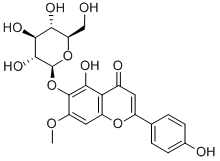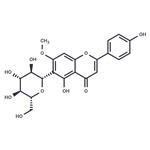Chemical Properties
Swertisin is a flavonoid compound that appears as a light yellow powder or crystalline powder at room temperature. Its chemical formula is C22H22O10, with a molecular weight of 446. it is soluble in organic solvents such as methanol and dimethyl sulfoxide. It has antioxidant,anti-diabetic, anti-depressant, anti-inflammatory, anti-viral, and anti-radiation pharmacological effects.
Definition
ChEBI: Swertisin is a flavone C-glycoside that is 7-O-methylapigenin in which the hydrogen at position 6 has been replaced by a beta-D-glucosyl residue. It has a role as a plant metabolite, an adenosine A1 receptor antagonist, an anti-inflammatory agent, an antioxidant and a hypoglycemic agent. It is a flavone C-glycoside, a monosaccharide derivative, a polyphenol, a monomethoxyflavone and a dihydroxyflavone. It is functionally related to an apigenin.
Biological Activity
Swertisin is a flavonoid C-glycoside that has been found in Swertia japonica and has diverse biological activities. It inhibits sodium-glucose cotransporter 2 (SGLT2) in HEK293 cells when used at a concentration of 7.5 μg/ml and is an adenosine A1 receptor antagonist (IC50 = 137 μM). Swertisin (0.2-5 μM) inhibits hepatitis B virus (HBV) replication in HepG2 2.2.15 cells. It decreases blood glucose levels in a mouse model of diabetes induced by streptozotocin (Item No. 13104), as well as prevents scopolamine-induced increases in escape latency in the Morris water maze in mice.
References
[1] GURPRIT BHARDWAJ . Swertisin, a novel SGLT2 inhibitor, with improved glucose homeostasis for effective diabetes therapy[J]. Archives of biochemistry and biophysics, 2021, 710: Article 108995. DOI:
10.1016/j.abb.2021.108995.
[2] K. PATEL D. P. Biological importance and therapeutic benefit of swertisin: An overview of medicinal importance and pharmacological activities[J]. Current Bioactive Compounds, 2022. DOI:
10.2174/1573407218666220801113334.
[3] HONG-YAN XU . Anti-hepatitis B virus activity of swertisin isolated from Iris tectorum Maxim[J]. Journal of ethnopharmacology, 2020, 257: Article 112787. DOI:
10.1016/j.jep.2020.112787.



